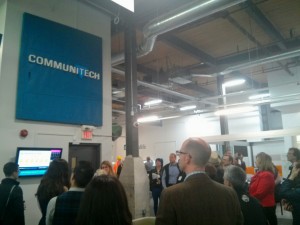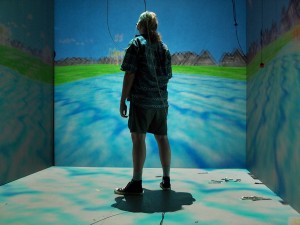
ArtsBuild had the opportunity to tour digital spaces in our own backyard at Orchestra’s Canada and Kitchener-Waterloo Symphony’s Digital Day. We traveled with 20 orchestras and professional musicians to some of Kitchener-Waterloo’s core tech companies including Communitech, Accelerator Centre and Google with the intention of immersing ourselves in the digital world.
Admittedly, the office culture of the tech industry (and the industry as a whole!) may have been unfamiliar ground for most arts administrators. But the work culture at these companies was really inspiring to see. These workplaces are buzzing with creativity and we were surrounded by tech creators undoubtedly working on some big project set to hit the digital market soon.
But why would a group of orchestras choose to spend a day learning about the world of tech? The answer is simple: learning about other sectors sparks new ideas.
Museums are taking a lead on virtual realities and image mapping. Earlier this month, The Globe and Mail published the article “The role of virtual reality and technology in the future of museums” which argues how museums are well positioned to take on the role of tech pioneers. The Canada Science and Technology Museum is testing the waters with a virtual reality (VR) headset that creates a simulation of 1936 CN 6400 steam locomotive. Visitors are essentially “going back in time” to experience culture. Plus, VR provides a creative interim solution to for the Canada Science and Technology Museum to connect with audiences while the museum remains closed for renovations.
 The Canadian War Museum is also embracing digital and are currently developing a Vimy Ridge virtual-experience to commemorate the centenarian year of the battle. The ROM in Toronto features augmented reality in their Tyrannosaurus Rex exhibit, which superimposes a digital dinosaur over ancient fossils.
The Canadian War Museum is also embracing digital and are currently developing a Vimy Ridge virtual-experience to commemorate the centenarian year of the battle. The ROM in Toronto features augmented reality in their Tyrannosaurus Rex exhibit, which superimposes a digital dinosaur over ancient fossils.
But integrating technology into these cultural institutions doesn’t detract from their traditional role as purveyors of the past. Digital realities are helping to educate audiences and make the content more accessible. Mark Keating, chief information officer at the ROM, interestingly points out in the article that the integration of digital experiences renders audience attendance as an outdated measure of success for museums. VR can be accessed anywhere– location and getting people in the door isn’t necessarily relevant for audiences to experience an emotional connection with the content.
So what does this mean?
Museums are using technology to compliment traditional exhibitions and educational programs. Those who have embraced the digital are breaking the mold of cultural presentation. They are inviting new audiences to experience their offerings, while maintaining a physical presence in their communities. But what is perhaps most important to take away from these examples is that digital immersion is not just a supplement to museum programming – it’s the future. The worlds of technology and the arts are coming closer together and the results are going to be extraordinary.

